Last updated:
‘Stucco and Shopping: Melbourne's Nineteenth Century Commercial Terraces’, Provenance: The Journal of Public Record Office Victoria, issue no. 9, 2010. ISSN 1832-2522. Copyright © Christine Graunas.
Melbourne is one of the world’s best-preserved Victorian cities, with a wide variety of nineteenth-century buildings. Common but frequently ignored in architectural surveys are the two-storey commercial terraces that line the shopping strips, particularly of the inner suburbs. These buildings, which contribute a great deal to the character of the city, well repay investigation.
The present article discusses the structure and decoration of a range of commercial terraces, from the earliest examples in the 1850s with a Georgian character to those of the Boom period of the 1880s that feature extravagant stuccoed façades. Original records at PROV, newspaper advertisements, commissioned histories of inner-city suburbs, and secondary sources have all been drawn on to help identify who the builders and tenants were, and whether the premises were financially viable. The brief overview presented here is intended to raise awareness about this interesting, often neglected feature of our city, and offers suggestions for further areas of research.
Many factors – historic, geographic, economic – make individual cities unique. Melbourne is no exception, and its oft-noted liveability is due to many things, not least of which is the large number of attractive nineteenth-century buildings that survive. While much has been written about Melbourne’s grand public buildings and residences, a modest type of building is surprisingly ignored, yet it is among the most common on our high streets. This is the commercial or ‘shopping’ terrace – multiple shopfronts with residences over the shops. Such buildings appear in country towns and in the centre of the city, but are most numerous in the early suburbs, which grew at breathtaking speed as Melbourne developed throughout the second half of the century.
This brief survey is not meant to be authoritative. The author simply became interested in these buildings, which are such an important part of our streetscape, but was unable to find answers to questions about them in any one source, although they are mentioned in many references. This may be because the commercial terraces are somewhat taken for granted – they are so common, and they are generally not major public buildings. It is hoped that the information assembled here on their origins, features and some of the people associated with them will spark further interest and bring them more into the awareness of readers.
The holdings of Public Record Office Victoria (PROV) were essential to this article in illuminating the occupants of the buildings, the identities of their builders, and changes in economic conditions; the general collection was also invaluable. A further study, locating and dating individual buildings and mapping the streetscapes, would additionally use the resources of the collection.
Origins and Style
The Melbourne nineteenth-century commercial terrace is, if not unique, emblematic of Melbourne and has many features not found elsewhere. It owes its development to a number of varied sources.
The terrace structure is more generally associated with houses, but a ‘terrace’ is simply a row of identical homes (or shops) built with adjoining walls. Usually the term ‘terrace’ requires three or more units, although ‘free standing terrace’ is used for single buildings in the terrace form.[1] (The use of the term ‘terrace’ for small buildings such as two-unit houses or shops seems to be peculiarly Australian.) The obvious advantage of the terrace is that it saves space.
The terrace as we know it developed in England and came to its full glory in the grand terraces of John Nash in the early nineteenth century. There are famous examples of the form in Bath and Edinburgh. These Georgian buildings show a wonderful unity and create an impressive streetscape.
Translated to Australian cities, the terrace was more modest, but showed its British origins; the early architects had generally trained in Britain. In Melbourne, the Royal Terrace in Nicholson Street, Fitzroy (1854-56, attributed to John Gill)[2] is one of the earliest, with simple classical design, but adding the Australian veranda. A more modest example, claimed to be the oldest surviving residential terrace in Melbourne, is the Georgian style Glass Terrace at 64-78 Gertrude Street, Fitzroy, built for Hugh Glass, and generally thought to be designed by David Ross and Charles Webb between 1853 and 1856. The very first terrace houses, mostly in Sydney, were usually single-storey houses joined together, but the two-storey versions developed quickly.
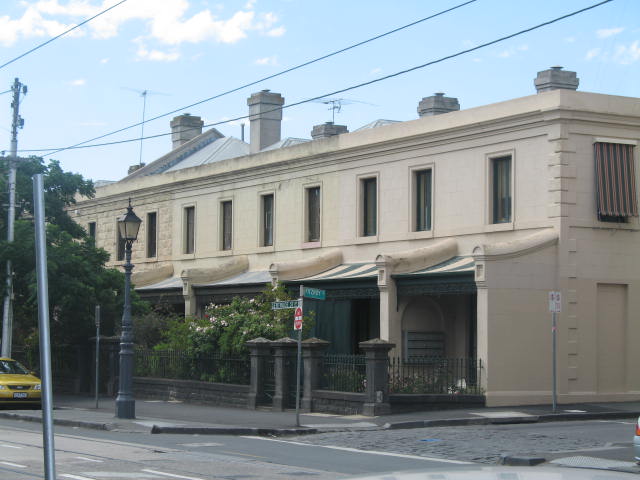
Photograph by Edward Terrell.
City shopfronts with residences attached for their owners have been around for centuries; they were common in ancient Rome. In the Renaissance, the Italian architect Donato Bramante designed a building known as the House of Raphael (now destroyed) with a row of shops on the ground floor and living quarters above, based on a classical prototype.[3] In Georgian London, rebuilt after the Great Fire, high street shops included rows of three-storey houses with shops on the ground floor; it was a ‘cramped mosaic of commercial domesticity, where merchants lived above their counting houses’.[4]
The earliest Australian commercial premises were very modest, business generally being carried out from tents or small weatherboard structures. However, as Sydney, Hobart, and then Melbourne developed, the desire and need for more impressive and durable structures arose. The first commercial terrace in Sydney appears to have been James Underwood’s terrace in George Street (1826).[5] This was a classic Georgian terrace with shops, only two storeys tall, like Bramante’s, rather than three or more like English residential terraces or most commercial premises.
In Melbourne, some very early commercial terraces survive. One is Crossley’s Building (1848-49), on Bourke Street.[6] The builder is not known, although the first occupier of Crossley’s was the butcher William Crossley. The building shows the standard form that was to be common throughout the city – a row of shops with residential premises above, in a basically simple brick terrace building.

Photograph by Edward Terrell.
While other retail structures such as the department store and arcade developed throughout the remainder of the nineteenth century, the commercial terrace would become extraordinarily popular, occupying the primary positions for retail premises on the developing high streets of Melbourne’s growing suburbs.
Stylistically, the commercial terrace follows the development of other buildings, although it is useful to note, as scholars have pointed out, that the use of historic styles was so widely and freely applied in the nineteenth century that it is very risky to try to date a building by its style, and also that trends in commercial building architecture changed with even more rapidity than those of domestic dwellings.[7] Of course, many of the comments below in regard to style and construction apply to many buildings of the period, not just to the shops, which are distinguished from terrace houses primarily by their interior structure and façade; but the intent is simply to describe the elements that did go into the making of these buildings.
Nineteenth-century architecture is characterised by its eclecticism as well as its references to earlier periods; and Australian architecture tended to follow the trends in Britain, although frequently a few steps behind. There were, however, also American and other influences, and Australian architects and builders added their own touches, particularly towards the end of the century in the period of ‘Marvellous Melbourne’ and heading towards Federation. The veranda appears to be an Australian addition, but based on intercolonial exchange.[8]
While commercial terraces can be classified by style, and the trend is towards more ornate styles as the century progresses, no distinct lines can be drawn. One type merges gradually into another, and earlier types appear synchronously with later ones. Simply for descriptive purposes, it is possible to identify three general styles or periods: Early, Standard or ‘Classical’, and Late (‘Boom’). One source refers to Regency, Early Victorian and Boom; various conservation studies to Early Victorian or Victorian; and other writers use the terms ‘free classical’ and ‘Victorian filigree’.[9] However, in terms of commercial terraces it is simplest to refer to the Early terraces of the 1850s; the various Standard examples which range through the 1860s, 1870s and early 1880s; and the Late or Boom period of the later 1880s until the economic crash of 1892. Georgian terraces exist, but primarily in New South Wales and Tasmania prior to 1850, and therefore are not relevant to this article, although there are some Georgian warehouses, such as those on Queen Street; and the Georgian influence does persist (see below).
(At this point it should be mentioned that in the majority of commercial terraces, the ground-floor shopfronts are not original. Most have been ‘renovated’ several times; verandas have been removed. Therefore it is difficult to discuss them stylistically, and the discussion here will be primarily regarding the first-storey façades of the buildings. However, shopfronts will be discussed to some degree further on.)
Early commercial terraces are basically simple buildings without much ornamentation – symmetrical brick or stone buildings of a Georgian style, although of a later date, with the addition of some mouldings, lintels, and possibly classical orders and/or rustication on the ground floor. There may be simple parapets but no large pediments, and verandas may exist. There are generally simple glazed double-hung windows on the first storey, two to a bay. The earliest Melbourne commercial terraces are of this type, such as Crossley’s, discussed above. Another example is the building at 61-67 Errol Street, North Melbourne, which appears to have been built in 1852-54. According to the present owner, it holds the longest established pharmacy in Victoria, and once housed a fish and chips shop as well. Charles Atkins, chemist, held the premises in 1854. The building has a simple parapet, rusticated pilasters, window mouldings and small urns, with no other decoration; the parapet may have been added later. The small plaque reading ‘Established 1853’ is off-centre, probably referring to the pharmacy in that portion of the building.[10]
In the Standard or Classical period, various additional features start to appear to add interest to the basic façade, such as larger parapets, small pediments, string courses, console brackets, some modillions, and more ornate urns and window mouldings. The familiar shopfront with a veranda decorated by iron lace occurs. Building surfaces are rendered. The effect of better examples is of a quiet classicism.[11]
A number of examples exist in Smith Street shops in Fitzroy from the 1860s and 1870s: the ‘W LAND’ (Welland?) Buildings (1875) with pediments and details on its pilasters; a two-bay terrace from 1867 with vermiculated quoins, brackets supporting a small parapet and square lintels; and a four-bay building from 1869 with a simple small pediment with the date and square window mouldings. While these buildings are very modest and rather battered, they do show a tendency for more decoration than in the earliest Georgian style terraces.
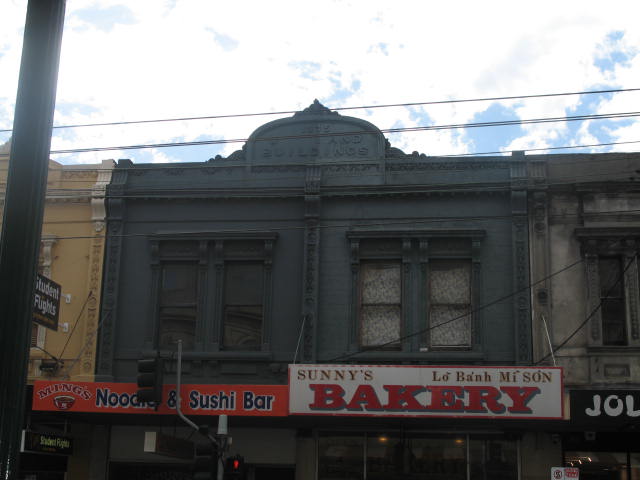
Photograph by Edward Terrell.
A later example and a common type is the building at 360-368 Chapel Street, South Yarra, which has a balustraded parapet, string course, pilasters with console brackets, and window mouldings with keystones; one original shopfront remains. The building is on the site of Prahran’s first church, which was demolished in 1883, logically the date of the building’s construction.[12] This building shows the Victorian classical influences of the time, but not the exuberant decoration of the Boom period, which was to follow in a very few years.
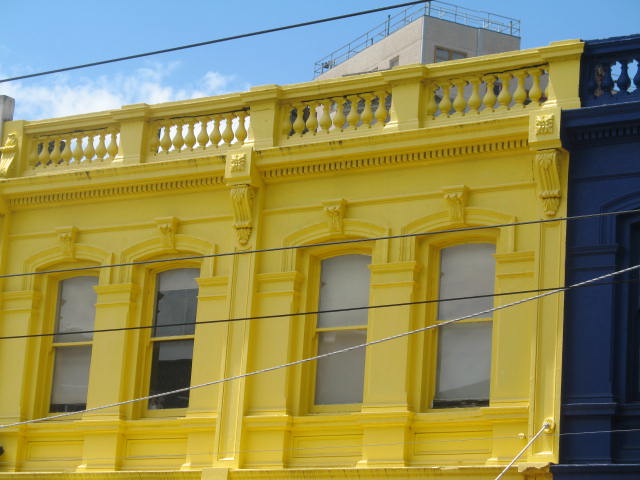
Photograph by Edward Terrell.
Finally we see the Boom style, influenced by developments in Europe such as Charles Garnier’s opera house in Paris. This is of course the period of ‘Marvellous Melbourne’, when the city was flush with funds and civic pride. Two international exhibitions were held, in 1880 and 1888, demonstrating Melbourne’s confidence in itself. The population had risen to nearly half a million, the suburbs were developing rapidly, and a building boom unlike anything seen before or since was in progress. In 1895-90, nine or ten buildings were completed each week.[13] The architects and builders of the time wished to embody the current spirit in their buildings; style and decoration should demonstrate the glory, success and grandness of the city. The chosen method was, quite literally, to throw everything they had into their work. The developing high streets of the new suburbs were a perfect place to construct new commercial premises, and these are where most examples of this period are still to be found.
The closest parallel to the Boom style is Mannerism, in which architects broke down and made free with the prevalent classical forms. The influence of the Italian Renaissance architect Palladio is present, but Melbourne’s builders and architects used any element they liked on their façades without much concern as to balance – architraves, columns, pilasters, balustrades, pediments, loggias, plus decorative masks, swags, ornamental keystones, consoles, string courses, urns, balls and various textures such as vermiculation. Sometimes there are also impressed designs, and toothed detailing around windows appears in some buildings; for instance, North Melbourne has quite a few examples. Many other ornaments are possible. A building on Victoria Street in North Melbourne has console brackets upside down over the veranda location, as do others around the city. The effects are sometimes wonderful and sometimes rather terrifying, but overall the Boom buildings are very characteristic of the Melbourne of the time, and we are fortunate that as many remain as do. The decorative features could be purchased wholesale from their manufacturers, and builders could ornament their basic buildings however their fancy took them (see below).
Boom terraces appear on all the major high streets of the period: for example, the Bleasby Buildings (1885) on Bridge Road, Richmond; Kinnaird’s Buildings (1891) on Johnston Street, Collingwood; the Gladstone Buildings on St George’s Road, North Fitzroy (1889); Conway’s Buildings on Chapel Street, Prahran (1890). There are many others. All include features such as elaborate window design, detailed string courses, elaborate pediments and various other decorative elements. The Gladstone Buildings include, logically, a sculpture of Gladstone.[14] The buildings become more and more elaborate as the end of the decade approaches; then, with the economic crash beginning in 1892, building slows and then nearly ceases altogether.
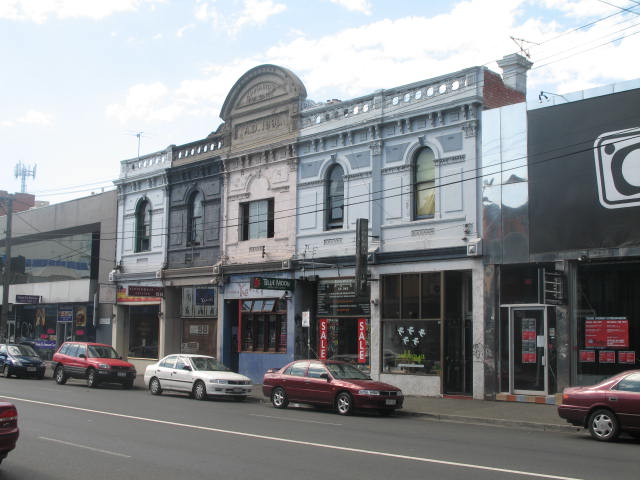
Photograph by Edward Terrell.
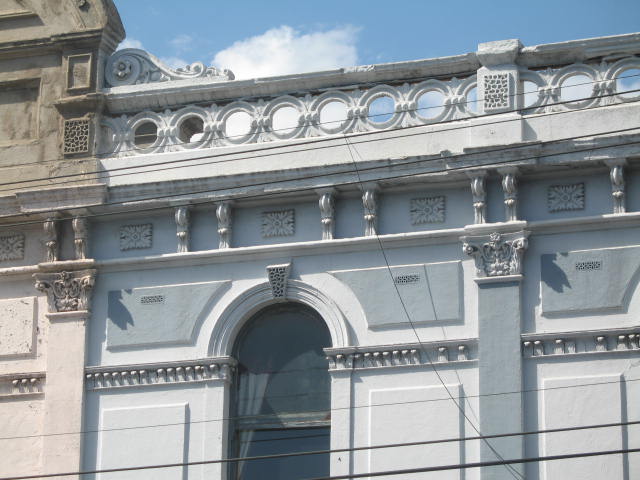
Photograph by Edward Terrell.
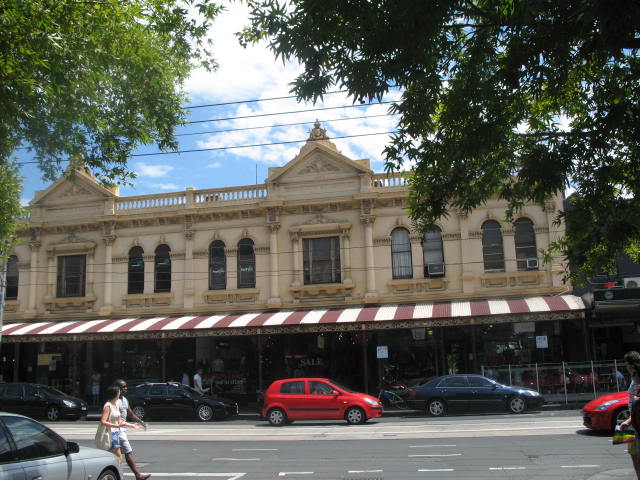
Photograph by Edward Terrell.
After 1900, and with Federation, things improved and building began again. The commercial terrace reappeared, with new features such as exposed brick rather than the ubiquitous stucco facing that characterised the earlier periods; the Stanford Block on Bridge Road, Richmond is an example of this.[15] Construction of commercial terraces continued throughout the Art Deco period of the twenties and thirties, and the basic principle is of course still in use today. The nineteenth century, however, was the heyday of this style of building.
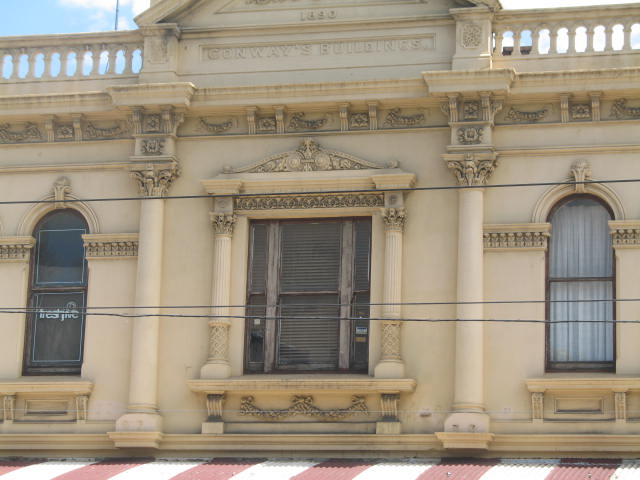
Photograph by Edward Terrell.

Photograph by Edward Terrell.
The Builders and the Buildings
The first fifty years or so of Melbourne’s building history have many interesting features. In an incredibly short time the settlement grew from nothing to a major city; this in spite of shortages of skilled workers and difficulties in obtaining materials. The builders of Melbourne were determined to create a city to awe and inspire, and largely succeeded. Shortcuts were taken where possible, though, and when it came to small commercial premises builders certainly took advantage of these.
Most qualified architects had been born and trained in Britain, and generally worked on the larger civic projects. Graeme Davison describes the structure of the building industry in the more speculative sectors as either:
Architect-builder -> Subcontractor -> ‘Improver’
or
Speculator-builder -> Architect-draftsman -> Subcontractor -> ‘Improver’.
According to Davison, in 1891 there were 470 architects in Melbourne, and 1041 builders (as well as 654 plasterers), but ‘architects’ could vary widely in their qualifications.[16]
Many designers and builders, therefore, probably had little training in architecture, and very likely would have relied on manuals and instruction books. One compilation of sources available to early Australian builders lists guides to carpentry, brickwork, concrete manufacturing and use, chimneys, foundations, glass, iron work, gas fitting, plumbing, and all manner of building skills.[17] For example, The builder’s jewel, by Batty and Thomas Langley, first published in 1741 and reprinted throughout the nineteenth century, includes plates of doorways, urns, Greek orders, and similar details.[18] Patterns for most features can be found in the builders’ and architects’ guides, especially those of the Classical period, including balustrades, urns, arches, and of course columns and pilasters.
Work was put out to tender, sometimes for the entire project or for certain aspects only. Large numbers of advertisements appeared in the Age and the Argus as well as in other publications such as the Australian builder and contractor’s news. For example, in the Age in January 1888, CJ Polain (the name appears in variant spellings in some sources when handwritten), architect of Footscray, ‘invites tenders for the erection of two and three story brick shops’. There are also tender offers for carpenters, masons, plasterers and plumbers, for various buildings.
Some builders became very successful. Thomas Cockram, for instance, arrived in Australia in the 1850s and worked as a bricklayer. By 1867 he is listed in the directories as ‘Thomas Cockram, builder’. He established premises on Peel Street in Hotham (North Melbourne) and later in O’Connell Street. As a builder he tendered for schools and railway stations. His son followed him into the business, and by the 1880s Cockram and Co. was responsible for some of the major buildings in Melbourne, such as the Princess Theatre and the Lygon Buildings in Carlton. The firm still continues today.[19]
While some actual architects seem to have been responsible for only a building or two, others were hugely successful. E Twentyman or his firm Twentyman & Askew is listed on 76 applications to build for houses, shops and other buildings between 1878 and 1914 (although only four of them are after 1890).[20] Since many applications to build do not list architects, however, it is difficult to trace the success or lack of it of various architect-builders, although this would be an interesting project.
The commercial buildings themselves were basic in their construction.[21] They would be based on a foundation of bluestone and aggregate, sand and/or cement, dug by hand. The basic building material was brick; in 1885 there were 227 brickyards in greater Melbourne, according to the Victorian year-book. While early bricks had often been soft, good quality bricks were being made by the 1880s, and by the end of the decade the Hoffman Patent Steam Brick Co. was turning out more than forty million bricks a year.[22]
Some buildings had a cavity wall, but most terraces were solid brick, possibly three layers thick on the bottom storey, two on the top. Lime mortar was used, with the lime brought in on drays, dumped at the site, mixed, and then left for a week to cool. This type of mortar set well, and cement was not used. Portland cement appeared only later, and was initially imported.
Early roofs were generally of slate. Iron was used for verandas (see below) and for later roofs, especially after the 1870s when it became more widely available.[23] Interiors were render and set (plaster), sometimes with a dado, and floors were generally of wood. The basic structure was simple; but this was countered by the ornament on the exterior.
The poor quality of early bricks, plus the desire of the builders to make the buildings look impressive, that is, look like stone, meant that until very late in the nineteenth century nearly all commercial buildings were faced with render: stucco of lime and sand. (On some buildings, the stucco was lined to simulate stone.) Decoration was used freely, as mentioned above, although only on the façades; sides were left undecorated, unless the building was on a corner and sometimes not even then. While decoration could have been carved or cast by craftsmen (some from Italy, according to somewhat unsubstantiated legend), the increased desire for ornament gave birth to a new trade – the ‘architectural modeller’, who cast decorative ornaments in a factory for both interior and exterior use. The exterior ornament was generally of ‘artificial stone’, or pressed cement. The use of modellers meant a drop in price, which probably made such ornamentation even more popular. Stucco was not universally loved, however; ‘N.B.’, in the Argus of 29 July 1880, refers to ‘Melbourne’s greatest architectural curse – stucco’.[24]
Modellers’ advertisements appear frequently in the papers of the time; the Victorian contractors’ and builders’ pricebook as early as 1859 lists:
J Sullivan, Architectural Modeller
Soffits, Centre Flowers, Corinthian & Ionic Plaster Capitals, Vases, Balusters, Scrolls, Wreaths, Swags of Fruit, Chimney Pots, etc.
‘Improved artificial stone’[25]
The present-day firm of Picton Hopkins had its origins in 1857; John Hopkins, a Welsh plasterer, came to Melbourne in 1854. The Sands & McDougall’s Melbourne and suburban directory for 1888 lists ‘Hopkins, Morgan & Co.’ under ‘modellers, moulders, figure makers and ornamental workers’, and M Hopkins under ‘plasterers’. The firm is still owned and run by the same family. Much of Melbourne’s ornamental interior plaster work and exterior decorative work of the Victorian period (and later) came from this company. The firm had a catalogue known as ‘the Green Book’. A copy from the 1920s in the collection of the State Library of Victoria lists the company’s work as including the Princess and Regent Theatres and the Melbourne Athenaeum.[26] Ornaments that could be ordered included urns, brackets, masks, and acanthus mouldings. The ornaments were generally cast in the factory (although some work was done on site), and then attached to the buildings with metal dowels and a slurry of sand and cement.[27] The relatively small number of firms supplying such ornaments may explain why we see the same figures on so many buildings.
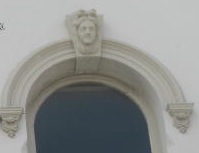
Photograph by Edward Terrell.
The Victorian year-book for 1885-86 lists, in addition to 43 stone and marble carvers, one ‘artificial stone’ manufacturer, two statuary works, and ten architectural modellers. Sands & McDougall list fifteen names under ‘modellers, moulders, ornamental metal workers and figure makers’ in 1885, some of whom also designated themselves as architects. A builder could simply decide on the ornaments desired, and order them from one of these suppliers.
Prices were fairly standard. Mayes’s Australian builders’ price-book of 1886 lists the following:
| Stone | |||
| Ionic capital for | £ | s | d |
| 6-inch column | 1 | 14 | 0 |
| 9-inch column | 2 | 10 | 0 |
| 12-inch column | 3 | 10 | 0 |
| Corinthian capital for |
|||
| 6-inch column | 3 | 0 | 0 |
| 9-inch column | 5 | 0 | 0 |
| 12-inch column | 8 | 0 | 0 |
| Mask | |||
| 4 inch | 6 | ||
| 6 inch | 12 | ||
| 9 inch | 16 |
| Modelling and casting | Modelling in clay (s) | Plaster casting (s) |
| Ionic capital 12? | 80 | 40 |
| Corinthian capital 12? | 100 | 60 |
| Modillion, enriched 4? | 20 | 2 |
| Rosette | 8 | 1 |
| Head on keystone 12? | 18 | 10 |
| Portland cement stucco pilasters, friezes and pedestals, per foot – labour 9d, materials 9d[28] | ||
Other prices are also listed. Plaster casting was less expensive than stone or clay; and cement castings were even cheaper. The popularity of cast cement continued to increase due to the low cost and the ever greater desire for ornament.
The decoration of the façades of commercial terraces is of course primarily on the upper storeys. The ground floor is occupied by the shopfront. Many of these, as mentioned previously, have been completely destroyed. Fortunately, however, a number have been preserved, which we can still enjoy.
The early shopfront made a great use of glass, to display goods and to bring light into the shop. Italian glass was imported for early shops, and plate glass soon became widely available.[29] The glass was set in timber mullions. The door was frequently set back, with perhaps a tiled entry floor. Around and between the glass fronts we find cement pillars; sometimes decorative tiles or mirrors were added. Over doors and at the tops of the windows decorative glass was used. In earlier shopfronts this would be etched glass; in later examples, into the early 1900s, when timber mullions were replaced by metal, leaded stained glass began to appear. The shopfronts themselves are an area of great interest, beyond the scope of this article; the above simply touches on some of their features.
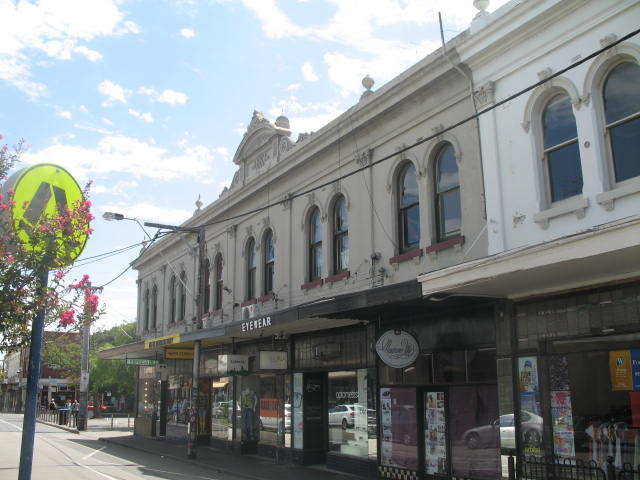
Photograph by Edward Terrell.
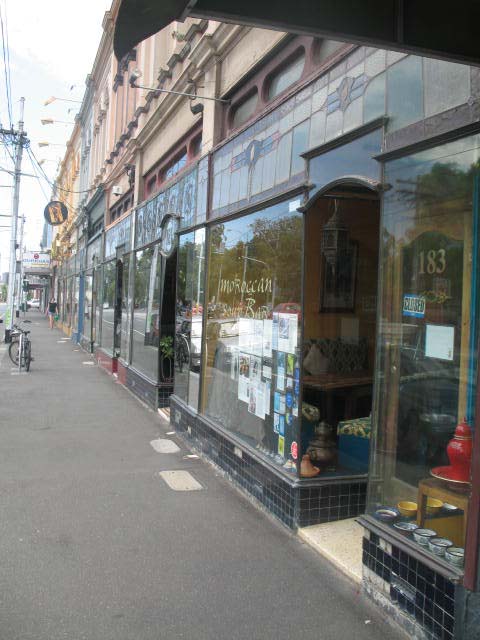
Photograph by Edward Terrell.
The vast majority of shops would have had a veranda. Unfortunately, many of these were removed in the 1950s or earlier; a few have been restored. However, a number of original verandas remain – Rathdowne Street in Carlton, for example, has some fine ones, as does the Queen Victoria Market. The classic veranda had metal supports with the crest of the city of Melbourne on them and an ironwork frieze, although wooden supports were also used. The veranda was covered with a corrugated iron roof, sometimes striped to resemble the original canvas awnings.
The shopfronts were designed, as shopfronts will always be, to entice the passerby to the wonders of the goods inside. The nineteenth-century Melburnian, especially in the later decades, was anxious to acquire the latest thing to demonstrate sophistication and success; and the merchants and builders were happy to oblige.
The Owners, the Merchants and the Community
Who were the men behind Melbourne’s commercial terraces? Each building required an architect of some sort, a builder, and someone to pay the bills. As we have seen, the line between builder and architect was at times very thin; similarly, builders could be contractors or could be building for themselves. The goal could be either an investment, with hoped-for returns from rents, or the building could be resold.
For example, in the 1880s the Age carried advertisements such as ‘Splendid shops, Chapel-St. Grand Dwellings. From 45s. to 50s. … S. Yarra’, and ‘Three two-story brick shops and dwellings [in Flemington Road, North Melbourne], each containing shop and five rooms; let at 51s. per week’.[30] Whatever the case, the owner/financier of the project would have expected a good return for his money.
Alexander Kemp, for example, who came to Victoria from Scotland in 1857,[31] was a builder and contractor who is shown in the records as the builder for several shops in Carlton in the 1880s, although he was not the owner. He is listed, however, as owner and builder of a shop in Rathdowne Street, as are William Perry, G Ford, and several others.[32]
Builders such as Kemp could specialise in a certain area of town; the owners also had their favourite districts. In Prahran, Francis Conway owned a number of buildings in Chapel Street.[33] Thomas Kilpatrick owned buildings in Greville Street, and ‘Ann’s Terrace’ is named after his wife.[34]
While we can assume that in the boom years ownership of commercial buildings was a profitable undertaking, especially in the expanding suburbs, after the crash of 1892 many owners must have found their income severely reduced. The Prahran Rate Books from 1893-94 show a number of shops and residences listed as ’empty’.[35] The National Bank manager in East Collingwood stated even in late 1891, as economic troubles started to appear, that ‘Empty houses and shops were to be seen on all sides’.[36]
In better days, however, the commercial terrace shops and residences were filled with the suppliers of all of Melbourne’s needs. Conway’s shops in Prahran included drapers, tailors, caterers, jewellers, hatters and bootmakers.[37] Agents of various sorts, printers, photographers, booksellers, furniture dealers, tobacconists and tearooms were common. An Argus advertisement from 1888 lists ‘A Grand Opportunity for drapers, boot dealers, grocers, ironmongers, chemists, and others’.[38] There were few types of retailer or tradesman who did not occupy such shops. One study lists 30 per cent of households as ‘commercial’ in 1891.[39] This would have meant hundreds of small shops and shopkeepers.
The shopkeepers were hard-working. Shops were generally open from 8 am to 6 pm on weekdays and 8 am to 1 pm on Saturdays by the end of the century, and had been open even longer hours previously.[40] Probably few shopkeepers could afford assistants; most businesses were run by a single proprietor or were family concerns. RN Twopeny in Town life in Australia estimated a shopkeeper’s income in the late 1800s (presumably after business expenses) to be in the range of 300-400 pounds per year,[41] or roughly six to eight pounds per week. Graeme Davison estimates that this places the shopkeeper below the professional but above the artisan in terms of income.[42]
The newspaper advertisements for shops to let tell us the costs of renting premises. In 1888, these range from the Melrose shops mentioned above at 51 shillings per week, which must have been quite grand, to ‘Shop, Richmond, near Burnley station; dwelling, 3 rooms; 12s’. Another lists ‘Shop, Richmond, suitable general store; 4 rooms, bath, gas, copper; 17s. 6d.’[43] A five-room shop was going for 30 shillings. If Twopeny’s estimate of income is correct, the expense of a shop to the shopkeeper, particularly considering that it included housing as well as the shop, was not excessive. Obviously, of course, income and cost would vary depending on the type of shop and its location. Some trades were more profitable than others. Not surprisingly, women’s trades, such as that of dressmaker, were less lucrative, even though many women were in trade: on one North Melbourne street in 1885, one-third of the shops were run by women, including groceries, a general store, and fancy goods merchants.[44]
The premises themselves were comfortable. Plans in the collection of the State Library of Victoria for one two-unit shop and residence, for example,[45] show a dining room to the rear of the shop with the kitchen and scullery behind on the ground floor, and three bedrooms plus drawing room on the upper floor. The toilet (on the pan system) would of course be separate at the back. Upstairs there was also a bathroom – tin baths were common.[46] The terraces had gas light and water, as the advertisements indicate, with a woodstove for cooking. While the lack of windows on the sides tends to make terraces dark, the ‘tailback’ design lets more light enter the rear of the home. An interior wooden stairway, often quite elegant, led from the ground to the first floor.
Nevertheless, life could be a struggle for shopkeepers. According to one writer, ‘the small shopkeepers who rented or built the stucco buildings which still line many suburban streets were a type all their own, whose limited horizons and extreme miserliness were essential to their survival’. The same source also claims that the small shopkeeper was ‘regarded as working with his hands and therefore not eligible to the ranks of social leadership’,[47] although if a shopkeeper managed to purchase premises through hard work, as some did, this could be a step up.
However, although shopkeepers may have struggled and were not regarded as of the upper crust, keeping a shop in a high street terrace, at least prior to the depression of the 1890s, seems to have been a decent living. It is also hard to believe that in the Melbourne of the day at least some shopkeepers were not welcomed and valued members of the communities they served.
Today
Some of Melbourne’s nineteenth-century commercial terraces are now gone and some are in a sad state of repair, but many are still in full use. Shopkeepers, however, less frequently live over their shops; and since most shops had and still have internal stairways, the upstairs living premises are often unused. In a city with an acute housing shortage, this seems a terrible waste. Perhaps a program could be devised to aid in converting these upper levels into flats, providing more living space plus income for the owners of the buildings.
In any case, Melbourne’s nineteenth-century commercial terraces continue to be a vital part of our city. They provide space for the huge number of small independent retail outlets, restaurants and cafes that help to make life in Melbourne so pleasant. Their loss would greatly change the city’s appearance and character. It is hoped that this brief overview will encourage awareness and appreciation of these buildings, so that they will be maintained and preserved for the future. Much more work could be done.
Endnotes
[1] Definition from B Turner, The Australian terrace house, Angus & Robertson, Pymble, NSW, 1995, p. 12.
[2] R Apperly, R Irving & P Reynolds, Pictorial guide to identifying Australian architecture, Angus & Robertson, Pymble, NSW, 1994, p. 47.
[3] See P Murray, Architecture of the Italian Renaissance, new revised edn, Thames & Hudson, London, 1986, p. 128.
[4] J Summerson, Georgian London, Barrie & Jenkins, London, 1988, pp. 37, 41.
[5] Turner, p. 19.
[6] P Goad, Melbourne architecture, Watermark Press, Sydney, 1999, p. 19.
[7] T Howells & C Morris, Terrace houses in Australia, Lansdowne, The Rocks, NSW, 1999, p. 85.
[8] Sir Banister Fletcher’s A History of Architecture, ed. D Cruickshank, 20th edn, Architectural Press, London, 1996, p. 1278.
[9] See for instance Howell & Morris, and Apperley et al.
[10] M de Lacy Lowe, See Melbourne by tram, New Holland, Frenchs Forest, NSW, 2001, p. 149; G Butler, North and West Melbourne Conservation Study, Melbourne City Council, 1983.
[11] Modillions and console brackets are types of decorative supports for various elements. Vermiculation means that the feature is textured so that it appears ‘eaten by worms’.
[12] See under ‘History’ in Wikipedia article ‘Chapel Street, Melbourne’, available at <http://en.wikipedia.org/wiki/Chapel_Street,_Melbourne>, accessed 22 October 2010
[13] M Lewis, Melbourne: the city’s history and development, 2nd edn, City of Melbourne, 1995, p. 80.
[14] William Ewart Gladstone, British Prime Minister on four occasions between 1868 and 1894.
[15] This building appears in a 1908 photo in John O’Connor et al., Richmond Conservation Study, 2 vols, City of Richmond, 1985, vol. 1, p. 100 (Fig. 4.70). This study is available on the City of Yarra website, available at <http://www.yarracity.vic.gov.au/Planning–Building/Studies-Strategies-and-Guidelines/Heritage-Studies/Richmond-Vol-1/>, accessed 22 Ocotober 2010.
[16] G Davison, The rise and fall of Marvellous Melbourne, 2nd edn, Melbourne University Press, 2004, pp. 89, 86.
[17] S Bathgate, Information sources available to early Australian builders, the author, Bungwahl, NSW, 1986.
[18] B & T Langley, The builder’s jewel; or, the youth’s instructor, and workman’s remembrancer, printed for R Ware, London, 1741.
[19] See M Turner Shaw, Builders of Melbourne, the Cockrams and their contemporaries, 1853-1972, Cypress Books, Melbourne, 1972.
[20] PROV, VA 511 Melbourne, VPRS 9462/P3, Index to architects named in notices of intention to build (Burchett index, microfiche), Units 24 and 25.
[21] Special thanks are due for this section to Mr Tom Carson of Heritage Restoration Company; and also to Mr David Cook, builder. See also JM Freeland, Architecture in Australia: a history, FW Cheshire, Melbourne, 1968, chapters on Victorian architecture, particularly pp. 143, 146.
[22] Davison, The rise and fall of Marvellous Melbourne, p. 59.
[23] See Lewis et al., p. 79.
[24] Quoted in J Grant & G Serle, The Melbourne scene 1803-1956, Melbourne University Press, 1957, p. 177.
[25] C Mayes, The Victorian contractors’ and builders’ pricebook, the author, Melbourne, 1859.
[26] Picton Hopkins & Son, General catalogue of decorative plaster designs, Picton Hopkins, Richmond, Vic., [c. 1920].
[27] Information obtained from the Picton Hopkins website, available at <http://www.pictonhopkins.com.au/about/index.htm>, accessed 22 October 2010, and from a personal telephone interview with Mr Picton Andrew Hopkins of Picton Hopkins, July 2010, to whom thanks are due for his assistance. See also A Sutherland, Victoria and its metropolis: past and present, 2 vols, McCarron, Bird, Melbourne, 1888, p. 643.
[28] C Mayes, The Australian builders’ price-book, 5th edn, G Robertson, Melbourne, 1886.
[29] W Bate, ‘How did people live in Victoria a century ago – life in 19th century Victoria’, six talks on ABC radio; Talk 5, Marvellous Melbourne, broadcast 17 October 1966 (transcript in State Library of Victoria).
[30] Age, 2 April 1888, p. 2b and 19 October 1889, p. 6h.
[31] Sutherland, Victoria and its metropolis, p. 644.
[32] PROV, VA 511 Melbourne, VPRS 9463/P3 Notices of intention to build (Burchett Index, microfiche), Unit 129, 1881; Units 146 to 149, 1886.
[33] PROV, VA 2491 Prahran II, VPRS 2344/P Prahran Rate Books (microfilm), Units 24 & 25, 1887-88.
[34] Nigel Lewis & Associates, Prahran conservation study: identification of buildings and areas of major significance, [1983], p. DC-26.
[35] PROV, VPRS 2344/P, Units 34 & 35, 1893-94.
[36] Quoted in B Carroll, Melbourne: an illustrated history, Lansdowne, Melbourne, 1972, p. 74.
[37] PROV, VPRS 2344/P, Units 24 & 25.
[38] Argus, 12 March 1888, p. 10d.
[39] A Larson, Growing up in Melbourne: family life in the late nineteenth century, Australian National University, Canberra, Demography Program, 1994, p. 210.
[40] M Cannon, Life in the cities, Australia in the Victorian age: 3, Thomas Nelson (Australia), West Melbourne, 1975, p. 283.
[41] Cited in Davison, p. 174.
[42] ibid., p. 253.
[43] Age, 4 January 1888, p. 3i.
[44] W Roberts, Molesworth Street: a North Melbourne neighbourhood, Annals of Hotham: 3, Hotham History Project, North Melbourne, 2002.
[45] Picture collection of the State Library of Victoria, WD SHO 40-1, ‘Two-storied shops for R Walters, Cnr Glenferrie Road & Liddiard Street, Hawthorn’ (exhibited in ‘Til you drop: Shopping, a Melbourne history’, State Library of Victoria, December 2009 – October 2010).
[46] Freeland, Architecture in Australia, p. 131.
[47] Cannon, pp. 200, 211.
Material in the Public Record Office Victoria archival collection contains words and descriptions that reflect attitudes and government policies at different times which may be insensitive and upsetting
Aboriginal and Torres Strait Islander Peoples should be aware the collection and website may contain images, voices and names of deceased persons.
PROV provides advice to researchers wishing to access, publish or re-use records about Aboriginal Peoples
